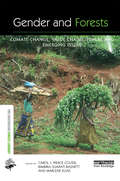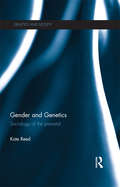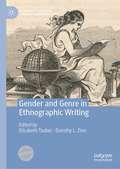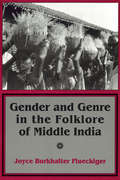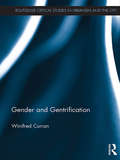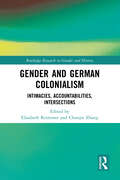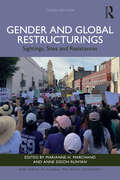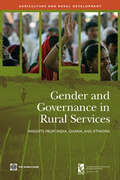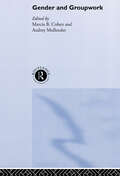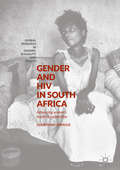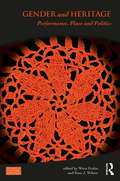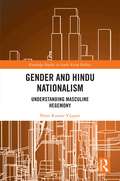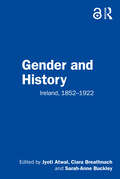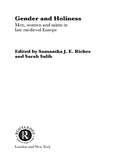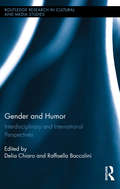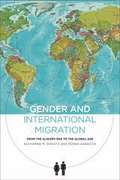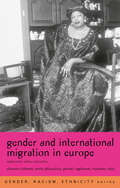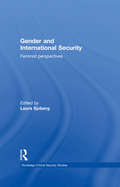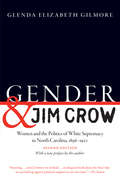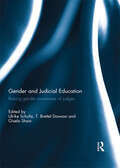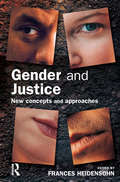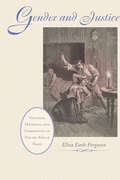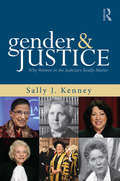- Table View
- List View
Gender and Firearms: My Body, My Choice, My Gun (Routledge Research in Gender and Society)
by Peter SquiresPrivate gun ownership for self-defense remains a major personal and public issue in the United States, driven by concerns about crime, vulnerability and a range of ‘ideological’ factors, including race and gender. As media attention centres upon the extent to which women are taking up firearms, with the gun lobby and firearms manufacturers celebrating the ‘new armed woman’, and guns being promoted as ‘Rape Prevention Kits’, this book explores the changing gendered aspects of gun ownership.Can ownership of firearms by women be considered, as some have claimed, the embodiment of what might be termed ‘pioneer feminism’, as women resist male violence in a dangerous world, or are different stories told by the prominence of women in firearms control campaigns, or the fact that women remain frequent victims of male gun ownership? Analysing representations of the ‘armed woman’ in firearm and gun lobby marketing and advertising campaigns, together with television and popular music forms, Gender and Firearms: My Body, My Choice, My Gun examines the directions taken in the public debate on weaponisation in the United States, considering the role of women in the politics of gun safety and gun control. The book draws on statistical evidence in order to shed light on trends in gun ownership, whilst engaging with feminist scholarship on the relationship between gender, violence, risk and vulnerabilities, thus opening up critical new debates surrounding identity, performance, gender and risk in contemporary societies.As such the book will be of likely interest to sociologists and scholars of sociology, criminology, and cultural and media studies with interests in gender, embodiment, risk, crime and violence.
Gender and Forests: Climate Change, Tenure, Value Chains and Emerging Issues (The Earthscan Forest Library)
by Carol J. Colfer Bimbika Sijapati Basnett Marlène EliasThis enlightening book brings together the work of gender and forestry specialists from various backgrounds and fields of research and action to analyse global gender conditions as related to forests. Using a variety of methods and approaches, they build on a spectrum of theoretical perspectives to bring depth and breadth to the relevant issues and address timely and under-studied themes. Focusing particularly on tropical forests, the book presents both local case studies and global comparative studies from Africa, Asia, and Latin America, as well as the US and Europe. The studies range from personal histories of elderly American women’s attitudes toward conservation, to a combined qualitative / quantitative international comparative study on REDD+, to a longitudinal examination of oil palm and gender roles over time in Kalimantan. Issues are examined across scales, from the household to the nation state and the global arena; and reach back to the past to inform present and future considerations. The collection will be of relevance to academics, researchers, policy makers and advocates with different levels of familiarity with gender issues in the field of forestry.
Gender and Genetics: Sociology of the Prenatal (Genetics and Society)
by Kate ReedPrenatal screening for genetic disorders is becoming an increasingly widespread phenomenon across the globe. While studies have highlighted the importance of women’s experiences of such screening, little is known about men’s roles and direct involvement in this process. With a focus on the experiences of both women and men, this text offers an innovative and passionate account of the gendered nature of prenatal screening. Drawing on interview data with pregnant women and their male partners in a UK city, Reed provides a compelling analysis of maternal and paternal roles in prenatal screening. Through this analysis, the book raises important issues around genetics, gender and screening practice. With a focus on the gendered production of ‘good’ and ‘bad’ genes, the book explores differences between visual technologies and blood screening. It also explores the gendered nature of genetic responsibility and the impact this has on parenting roles. Extending its arguments into other key debates in prenatal genetics – including a focus on the impact of screening on other types of stratification, including ethnicity and class – Reed provides an original and comprehensive analysis of some of the most pressing concerns in the field to date. This book will be of interest to students and scholars of the sociology of health and illness, science and technology studies, gender studies, feminist bioethics and medical anthropology, as well as professionals in the fields of midwifery and genetic counselling.
Gender and Genre in Ethnographic Writing (Palgrave Studies in Literary Anthropology)
by Elisabeth Tauber Dorothy L. ZinnThis book provides new insights into an intense and long-standing debate on women, gender, and masculinity with an explicit focus on ethnographic writing. The six contributors to this book investigate and discuss the multiple connections between ethnographic writing and gender in both the history of anthropology and contemporary anthropology, underlining problems, potentialities, stereotypes, experiments, continuities, changes, and challenges. Building on a prologue by two Malinowski grandchildren and an exploration of the role that Bronislaw Malinowski’s first wife, Elsie Masson, played in his literary presentation, the anthropologists collected here problematize writing gender and gendered writing in ethnography, revealing how these twin themes touch the history of the discipline itself and the classics of anthropology. Has the legacy of Writing Culture and Women Writing Culture obviated the need to consider gender in writing? Or could it be that the very mechanics of ethnographic writing are still imbued with hidden gendered divisions of labor? Following the editors’ extensive overview of the question, the contributing authors tackle gender and ethnographic writing from various vantages: with a view to the past, but also to the influence of previous feminist critiques in the present, and with accounts of the issues they themselves have faced and the solutions they have devised.
Gender and Genre in the Folklore of Middle India (Myth and Poetics)
by Joyce Burkhalter FlueckigerIn Gender and Genre in the Folklore of Middle India, Joyce Burkhalter Flueckiger analyzes six representative Indian folklore genres from a single regional repertoire to show the influence of their intertextual relations on the composition and interpretation of artistic performance. Placing special emphasis on women’s rituals, she looks at the relationship between the framework and organization of indigenous genres and the reception of folklore performance. The regional repertoire under examination presents a strikingly female-centered world. Female performers and characters are active, articulate, and frequently challenge or defy expectations of gender. Men also confound traditional gender roles. Flueckiger includes the translations of two full performance texts of narratives sung by female and male storytellers respectively.
Gender and Gentrification (Routledge Critical Studies in Urbanism and the City)
by Winifred CurranThis book explores how gentrification often reinforces traditional gender roles and spatial constructions during the process of reshaping the labour, housing, commercial and policy landscapes of the city. It focuses in particular on the impact of gentrification on women and racialized men, exploring how gentrification increases the cost of living, serves to narrow housing choices, make social reproduction more expensive, and limits the scope of the democratic process. This has resulted in the displacement of many of the phenomena once considered to be the emancipatory hallmarks of gentrification, such as gayborhoods. The book explores the role of gentrification in the larger social processes through which gender is continually reconstituted. In so doing, it makes clear that the negative effects of gentrification are far more wide-ranging than popularly understood, and makes recommendations for renewed activism and policy that places gender at its core. This is valuable reading for students, researchers, and activists interested in social and economic geography, city planning, gender studies, urban studies, sociology, and cultural studies.
Gender and German Colonialism: Intimacies, Accountabilities, Intersections (Routledge Research in Gender and History)
by Elisabeth Krimmer Chunjie ZhangThis book addresses the intersection between gender and colonialism primarily in German colonialism. Gender and German Colonialism is concerned with colonialism as a historical phenomenon and with the repercussions and transformations of the colonial era in contemporary racist and sexist discourses and practices relating to refugees, migrants, and people of non-European descent living in Europe. This volume contributes to the broader effort of decolonization with particular attention to concepts of gender. Rather than focus on only one European empire, it discusses and compares multiple former colonial powers in context. In addition to German colonialism, some chapters focus on the role of gender in Dutch and Belgian colonialism in Indonesia, Africa, and the Americas. This volume will be of value to students and scholars interested in women’s and gender studies, social and cultural history, and imperial and colonial history.
Gender and Global Restructurings: Sightings, Sites and Resistances (RIPE Series in Global Political Economy)
by Marianne H. MarchandIn the new edition of this bestselling text and scholarly reference, new and revised chapters reflect shifts in the gendered, classed, racialized and sexualized nature of ongoing global restructurings.Through fresh intersectional feminist analyses of widening health, climate, care, inequality, democracy and knowledge crises since the Great Financial Crisis and the deepening of many forms of capitalism, this volume stresses the complexities of multiple restructurings which demand new ways to think across sightings, sites and resistances. Some of each of these elements are in every chapter, which take the reader to different sightings, such as of neoliberalizations, neoauthoritarianizations, multipolarizations, financializations and migrations. They also bring into view different geographic sites, such as Hong Kong, sub-Saharan and North Africa, Canada, Mexico, Bangladesh and the trade blocs of the European Union and the BRICs, and different nongeographic sites such as productive and reproductive economies and the virtual economy of finance and digitalization. They further highlight different forms of women’s and feminist resistance, such as local and national labor organizing, regional and multipolar organizing, reimagining infrastructure design and broadening noncapitalist community and solidarity economies. Many chapters critique problematic constructions of women’s empowerment, and all challenge the machinations of neoliberal capital that undermine most women, marginalized peoples and the planet.Providing a coherent and challenging approach to contemporary gendered globalization, better understood as global restructurings, since the last edition over a decade ago, Gender and Global Restructurings will be of interest to students and scholars of international political economy, international relations, economics, development and gender studies.
Gender and Governance in Rural Services
by The World Bank International Food Policy Research Insti'Gender and Governance in Rural Services' provides policy-relevant knowledge on strategies to improve agricultural and rural service delivery with a focus on providing more equitable access to these services, especially for women. It focuses India, Ethiopia, and Ghana, and focuses on two public services: agricultural extension, as an example of an agricultural service, and on drinking water, as an example of rural service that is not directly related to agriculture but is of high relevance for rural women. It provides empirical microlevel evidence on how different accountability mechanisms for agricultural advisory services and drinking water provision work in practice, and analyzes factors that influence the suitability of different governance reform strategies that aim at making service provision more gender responsive. It presents major findings from the quantitative and qualitative research conducted under the project in the three countries, which are analyzed in a qualitative way to identify major patterns of accountability routes in agricultural and rural service provision and to assess their gender dimension. The book is intended for use by a wide audience interested in agricultural and rural service provision, including researchers, members of the public administration, policy makers, and staff from nongovernmental organizations (NGOs) and international development agencies who are involved in the design and management of reform efforts, projects, and programs dealing with rural service provision.
Gender and Groupwork
by Audrey Mullender Marcia B. CohenThinking about gender can enrich the work of all groupwork practitioners and can make a real difference in people's lives. Based on practice experience in both the UK and the USA, Gender and Groupwork brings together the best of groupwork knowledge, skills and values in a true transatlantic partnership.The book summarises the history of gender-based groups for both women and men and outlines a wide range of exciting and challenging examples of groups in different contexts. Often moving, and always engrossing, these accounts encompass groups for older women and women facing inequalities in health care. Innovative work with homeless people, with caregivers and lesbian and gay youth is described in detail and there is a particular focus on domestic violence, where groups can often the intervention of choice.Gender and Groupwork demonstrates that, despite the challenges of post-structuralism and postmodernism, the practice of groupwork is alive and well. It provides new ideas and new models to help move practice forward, making it a welcome addition to the groupwork literature.
Gender and HIV in South Africa: Advancing Women's Health And Capabilities (Global Research In Gender, Sexuality And Health Ser.)
by Courtenay SpragueThis book addresses the ongoing problem of HIV in black South African women as a health inequity. Importantly, it argues that this urgent problem of justice is changeable. Sprague uses the capabilities approach to bring a theory of health justice, together with multiple sources of evidence, to investigate the complex problem of HIV and accompanying poor health outcomes in black South African women. Motivated by a concern for application of knowledge, this work discusses how to better conceptualise what health justice demands of state and society, and how to mobilise available evidence on health inequities in ways that compel greater state action to address problems of gender and health. HIV in women, and possible responses, are investigated on four distinct levels: conceptual, social structure, health systems, and law. The analysis demonstrates that this problem is indeed modifiable with long-term interventions and an enhanced state response targeted at multiple levels. This book will be of interest to academics and students in the social health sciences, gender and development studies, and global health, as well as HIV/health activists, government officials, policy makers, HIV clinicians and health providers interested in HIV.
Gender and Heritage: Performance, Place and Politics (Key Issues in Cultural Heritage)
by Wera Grahn Ross J. WilsonGender and Heritage brings together a group of international scholars to examine the performance, place and politics of gender within heritage. Through a series of case studies, models and assessments, the significance of understanding and working with concepts of gender is demonstrated as a dynamic and reforming agenda. Demonstrating that gender has become an increasingly important area for heritage scholarship, the collection argues that it should also be recognised as a central structuring device within society and the location where a critical heritage studies can emerge. Drawing on contributions from around the world, this edited collection provides a range of innovative approaches to using gender as a mode of enquiry. From the politics of museum displays, the exploration of pedagogy, the role of local initiatives and the legal frameworks that structure representation, the volume’s diversity and objectives represent a challenge for students, academics and professionals to rethink gender. Rather than featuring gender as an addition to wider discussions of heritage, this volume makes gender the focus of concern as a means of building a new agenda within the field. This volume, which addresses how we engage with gender and heritage in both practice and theory, is essential reading for scholars at all levels and should also serve as a useful guide for practitioners.
Gender and Hindu Nationalism: Understanding Masculine Hegemony (Routledge Studies in South Asian Politics)
by Prem Kumar VijayanThis book presents an innovative approach to gender, nationalism, and the relations between them, and analyses the broader social base of Hindu nationalist organisation to understand the growth of 'Hindutva', or Hindu nationalism, in India. Arguing that Hindu nationalist thought and predilections emerge out of, and, in turn, feed, pre-existing gendered tendencies, the author presents the new concept of 'masculine hegemony', specifically Brahmanical masculine hegemony. The book offers a historical overview of the processes that converge in the making of the identity ‘Hindu’, in the making of the religion ‘Hinduism’, and in the shaping of the movement known as ‘Hindutva’. The impact of colonialism, social reform, and caste movements is explored, as is the role of key figures such as Mohandas Gandhi, Indira Gandhi, and Narendra Modi. The book sheds light on the close, yet uneasy, relations that Hindu nationalist thought and practice have with conceptions of 'modernity', 'development' and women's movements, and politics, and the future of Hindu nationalism in India. A new approach to the study of Hindu nationalism, this book offers a theoretically innovative understanding of Indian history and socio-politics. It will be of interest to academics working in the field of Gender studies and Asian Studies, in particular South Asian history and politics.
Gender and History: Ireland, 1852–1922
by Sarah-Anne Buckley Jyoti Atwal Ciara BreathnachThis book provides an overview of Irish gender history from the end of the Great Famine in 1852 until the foundation of the Irish Free State in 1922. It builds on the work that scholars of women’s history pioneered and brings together internationally regarded experts to offer a synthesis of the current historiography and existing debates within the field. The authors place emphasis on highlighting new and exciting sources, methodologies, and suggested areas for future research. They address a variety of critical themes such as the family, reproduction and sexuality, the medical and prison systems, masculinities and femininities, institutions, charity, the missions, migration, ‘elite women’, and the involvement of women in the Irish nationalist/revolutionary period. Envisioned to be both thematic and chronological, the book provides insight into the comparative, transnational, and connected histories of Ireland, India, and the British empire. An important contribution to the study of Irish gender history, the volume offers opportunities for students and researchers to learn from the methods and historiography of Irish studies. It will be useful for scholars and teachers of history, gender studies, colonialism, post-colonialism, European history, Irish history, Irish studies, and political history.
Gender and Holiness: Men, Women and Saints in Late Medieval Europe (Routledge Studies in Medieval Religion and Culture #No.1)
by Samantha J. E. Riches Sarah SalihThis collection brings together two flourishing areas of medieval scholarship: gender and religion. It examines gender-specific religious practices and contends that the pursuit of holiness can destabilise binary gender itself. Though saints may be classified as masculine or feminine, holiness may also cut across gender divisions and demand a break from normally gendered behaviour. This work of interdisciplinary cultural history includes contributions from historians, art historians and literary critics and will be of interest not only to medievalists, but also to students of religion and gender in any period.
Gender and Humor: Interdisciplinary and International Perspectives (Routledge Research in Cultural and Media Studies)
by Delia Chiaro Raffaella BaccoliniIn the mid-seventies, both gender studies and humor studies emerged as new disciplines, with scholars from various fields undertaking research in these areas. The first publications that emerged in the field of gender studies came out of disciplines such as philosophy, history, and literature, while early works in the area of humor studies initially concentrated on language, linguistics, and psychology. Since then, both fields have flourished, but largely independently. This book draws together and focuses the work of scholars from diverse disciplines on intersections of gender and humor, giving voice to approaches in disciplines such as film, television, literature, linguistics, translation studies, and popular culture.
Gender and International Migration
by Donna Gabaccia Katharine M. DonatoIn 2006, the United Nations reported on the “feminization” of migration, noting that the number of female migrants had doubled over the last five decades. Likewise, global awareness of issues like human trafficking and the exploitation of immigrant domestic workers has increased attention to the gender makeup of migrants. But are women really more likely to migrate today than they were in earlier times? In Gender and International Migration, sociologist and demographer Katharine Donato and historian Donna Gabaccia evaluate the historical evidence to show that women have been a significant part of migration flows for centuries. The first scholarly analysis of gender and migration over the centuries, Gender and International Migration demonstrates that variation in the gender composition of migration reflect not only the movements of women relative to men, but larger shifts in immigration policies and gender relations in the changing global economy. While most research has focused on women migrants after 1960, Donato and Gabaccia begin their analysis with the fifteenth century, when European colonization and the transatlantic slave trade led to large-scale forced migration, including the transport of prisoners and indentured servants to the Americas and Australia from Africa and Europe. Contrary to the popular conception that most of these migrants were male, the authors show that a significant portion were women. The gender composition of migrants was driven by regional labor markets and local beliefs of the sending countries. For example, while coastal ports of western Africa traded mostly male slaves to Europeans, most slaves exiting east Africa for the Middle East were women due to this region’s demand for female reproductive labor. Donato and Gabaccia show how the changing immigration policies of receiving countries affect the gender composition of global migration. Nineteenth-century immigration restrictions based on race, such as the Chinese Exclusion Act in the United States, limited male labor migration. But as these policies were replaced by regulated migration based on categories such as employment and marriage, the balance of men and women became more equal – both in large immigrant-receiving nations such as the United States, Canada, and Israel, and in nations with small immigrant populations such as South Africa, the Philippines, and Argentina. The gender composition of today’s migrants reflects a much stronger demand for female labor than in the past. The authors conclude that gender imbalance in migration is most likely to occur when coercive systems of labor recruitment exist, whether in the slave trade of the early modern era or in recent guest-worker programs. Using methods and insights from history, gender studies, demography, and other social sciences, Gender and International Migration shows that feminization is better characterized as a gradual and ongoing shift toward gender balance in migrant populations worldwide. This groundbreaking demographic and historical analysis provides an important foundation for future migration research.
Gender and International Migration in Europe: Employment, Welfare and Politics (Gender, Racism, Ethnicity Ser.)
by Eleonore Kofman Parvati Raghuram Rosemary Sales Annie PhizackleaGender and International Migration in Europe is a unique work which introduces a gender dimension into theories of contemporary migrations. As the European Union seeks to extend equal opportunities, increasingly restrictionist immigration policies and the persistence of racism, deny autonomy and choice to migrant women. This work demonstrates how processes of globalisation and change in state policies on employment and welfare have maintained a demand for diverse forms of gendered immigration.The authors examine state and European Union policies of immigration control, family reunion, refugees and the management of immigrant and ethnic minority communities. Most importantly this work considers the opportunities created for political activity by migrant women and the extent to which they are able to influence and participate in mainstream policy-making.This volume will be essential reading for anyone involved in or interested in modern European immigration policy.
Gender and International Security: Feminist Perspectives (Routledge Critical Security Studies #17)
by Laura SjobergThis book defines the relationship between gender and international security, analyzing and critiquing international security theory and practice from a gendered perspective. Gender issues have an important place in the international security landscape, but have been neglected both in the theory and practice of international security. The passage and implementation of UN Security Council Resolution 1325 (on Security Council operations), the integration of gender concerns into peacekeeping, the management of refugees, post-conflict disarmament and reintegration and protection for non-combatants in times of war shows the increasing importance of gender sensitivity for actors on all fronts in global security. This book aims to improve the quality and quantity of conversations between feminist security studies and security studies more generally, in order to demonstrate the importance of gender analysis to the study of international security, and to expand the feminist research program in Security Studies. The chapters included in this book not only challenge the assumed irrelevance of gender, they argue that gender is not a subsection of security studies to be compartmentalized or briefly considered as a side issue. Rather, the contributors argue that gender is conceptually, empirically, and normatively essential to studying international security. They do so by critiquing and reconstructing key concepts of and theories in international security, by looking for the increasingly complex roles women play as security actors, and by looking at various contemporary security issues through gendered lenses. Together, these chapters make the case that accurate, rigorous, and ethical scholarship of international security cannot be produced without taking account of women's presence in or the gendering of world politics. This book will be of interest to all students of critical security studies, gender studies and International Relations in general. Laura Sjoberg is Assistant Professor of Political Science at the University of Florida. She has a Phd in International Relations and Gender Studies from the University of Southern California and is the author of Gender, Justice, and the Wars in Iraq (2006) and, with Caron Gentry, Mothers, Monsters, Whores: Women's Violence in Global Politics (2007)
Gender and Jim Crow
by Glenda Elizabeth GilmoreGlenda Gilmore recovers the rich nuances of southern political history by placing black women at its center. She explores the pivotal and interconnected roles played by gender and race in North Carolina politics from the period immediately preceding the disfranchisement of black men in 1900 to the time black and white women gained the vote in 1920. Gender and Jim Crow argues that the ideology of white supremacy embodied in the Jim Crow laws of the turn of the century profoundly reordered society and that within this environment, black women crafted an enduring tradition of political activism. According to Gilmore, a generation of educated African American women emerged in the 1890s to become, in effect, diplomats to the white community after the disfranchisement of their husbands, brothers, and fathers. Using the lives of African American women to tell the larger story, Gilmore chronicles black women's political strategies, their feminism, and their efforts to forge political ties with white women. Her analysis highlights the active role played by women of both races in the political process and in the emergence of southern progressivism. In addition, Gilmore illuminates the manipulation of concepts of gender by white supremacists and shows how this rhetoric changed once women, black and white, gained the vote.
Gender and Jim Crow, Second Edition: Women and the Politics of White Supremacy in North Carolina, 1896-1920 (Gender and American Culture)
by Glenda Elizabeth GilmoreThis classic work helps recover the central role of black women in the political history of the Jim Crow era. Glenda Elizabeth Gilmore explores the pivotal and interconnected roles played by gender and race in North Carolina politics from the period immediately preceding the disfranchisement of black men in 1900 to the time black and white women gained the vote in 1920. Gilmore argues that while the ideology of white supremacy reordered Jim Crow society, a generation of educated black women nevertheless crafted an enduring tradition of political activism. In effect, these women served as diplomats to the white community after the disfranchisement of their husbands, brothers, and fathers. Gilmore also reveals how black women's feminism created opportunities to forge political ties with white women, helping to create a foundation for the emergence of southern progressivism. In addition, Gender and Jim Crow illuminates the manipulation of concepts of gender by white supremacists and shows how this rhetoric changed once women, black and white, gained the vote.
Gender and Judicial Education: Raising Gender Awareness of Judges
by Ulrike Schultz, T. Brettel Dawson and Gisela ShawJudicial Education has greatly expanded in common law countries in the past 25 years. More recently it has become a core component in judicial reform programs in developing countries with gender attentiveness as an element required by donor agencies. In civil law jurisdictions judges´ schools have long played a role in the formation of the career judiciary with a focus on entry to the judicial profession, in some countries judges get an intensive in-service education at judicial academies. Gender questions, however, tend to be neglected in the curricula.These judicial education activities have generated a significant body of material and experience which it is timely to review and disseminate. Questions such as the following require answers. What is the current state of affairs? How is judicial education implemented in developed and developing countries all around the world? Who are the educators? Who is being educated? How is judicial education on gender regarded by judges? How effective are these programs?The chapters in this book deal with these questions. They provide a multiplicity of perspectives. Six countries are represented, of these four are civil law countries (Germany, Argentina, Japan, Bosnia and Herzegovina) and two are common law countries (Canada; Uganda). This book was previously published as a special issue of International Journal of the Legal Profession.
Gender and Justice
by Frances HeidensohnQuestions about gender, justice and crime are constantly in the public arena, whether they focus on young women getting drunk or taking drugs, or the rising numbers of women going to prison or committing violent crimes, or reports of macho behaviour on the part of men in the military, law enforcement or professional sport. This book provides a key text for students seeking to understand feminist and gendered perspectives on criminology and criminal justice, bringing together the most innovative research and work which has taken the study of the relationship between gender and justice into the twenty-first century. The book addresses many of the issues of concern to the established feminist agenda (such as the gender gap, equity in the criminal justice system, penal regimes and their impact on women), but also shows the ways in which these themes have been extended, reinterpreted and answered in new and distinctive ways. Organised into sections on gender and offending behaviour, gender and the criminal justice system, and new concepts and approaches, Gender and Justice: new concepts and approaches will be essential reading for students taking courses in criminology and criminal justice, and anybody else wishing to understand the complex and changing relationship between gender and justice.
Gender and Justice: Violence, Intimacy, and Community in Fin-de-Siècle Paris (The Johns Hopkins University Studies in Historical and Political Science #128)
by Eliza Earle FergusonHistorian Eliza Earle Ferguson’s meticulously researched study of domestic violence among the working class in France uncovers the intimate details of daily life and the complex workings of court proceedings in fin-de-siècle Paris. With detective-like methods, Ferguson pores through hundreds of court records to understand why so many perpetrators of violent crime were fully acquitted. She finds that court verdicts depended on community standards for violence between couples. Her search uncovers voluminous testimony from witnesses, defendants, and victims documenting the conflicts and connections among men and women who struggled to balance love, desire, and economic need in their relationships.Ferguson's detailed analysis of these cases enables her to reconstruct the social, cultural, and legal conditions in which they took place. Her ethnographic approach offers unprecedented insight into the daily lives of nineteenth-century Parisians, revealing how they chose their partners, what they fought about, and what drove them to violence. In their battles over money and sex, couples were in effect testing, stretching, and enforcing gender roles.Gender and Justice will interest social and legal historians for its explanation of how the working class of fin-de-siècle Paris went about their lives and navigated the judicial system. Gender studies scholars will find Ferguson’s analysis of the construction of gender particularly trenchant.
Gender and Justice: Why Women in the Judiciary Really Matter (Perspectives on Gender)
by Sally J. KenneyIntended for use in courses on law and society, as well as courses in women’s and gender studies, women and politics, and women and the law, this book explores different questions in different North American and European geographical jurisdictions and courts, demonstrating the value of a gender analysis of courts, judges, law, institutions, organizations, and, ultimately, politics. Gender and Justice argues empirically for both more women and more feminists on the bench, while demonstrating that achieving these two aims are independent projects.

